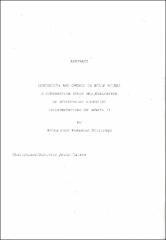Continuity and change in world rulers : a comparative study and evaluation of Seventh-day Adventist interpretations of Daniel 11
Abstract
Dan 11 is a prophecy about the forces of good and evil on the international scenario from
the time of Daniel until the end. The message of this revelation summarizes and expands the
preceding visions of Dan 2, 7, 8 and 9. Seventh-day Adventist historicists, though sharing a
common outlook of the book of Daniel as a whole, hold two views on this chapter. Most
interpret Dan 11:1-30 in a strictly historical way and 11:31-45 spiritually. They regard Dan 11
as the history of Medo-Persia (11:1-2), of Greece (11:3-15), of pagan Rome (11:16-30), of papal
Rome (11:31-39) and of the world during the time of the end (11:40-45). In contrast, Doukhan,
the main proponent of the second view, interprets 11; 1-4 historically and 11:5-45 spiritually. He
suggests that 11; 1-2 deals with Medo-Persia, 11:3-4b with Greece, 11-4c with pagan Rome, and
that 11; 5-45 applies to the power of the little horn after the fall of pagan Rome.
In view of this, a further study on the historicist interpretation of Daniel 11 has been done
to determine the validity of the respective arguments. Chapter 1 starts the study with a review of
relevant literature. Chapter 2 presents a comparison of the two views of historicism. Chapter 3
presents a grammatical-historical analysis of Daniel 11 and evaluates these two views. Chapter 4 deals with the summary and conclusion.
The difference centers on the interpretation of the “others beside these” in 11:4c.
Doukhan interprets the “others” of this verse as the Romans, and applies the “these” to the four
generals among whom Alexander’s empire was divided after his untimely death. However, a
study of the parallel construction of Dan 11;4 suggests that the “these” to whom the kingdom
goes is connected with (1) Alexander’s posterity and (2) his dominion, and that the “others” is
connected with the four divisions of the Greek empire and not with the Roman Empire.
Doukhans’s interpretation, then, is not seen as correct at this point. Nonetheless, the dissertation
points out a common Babelic/Luciferic character underlying the successive powers depicted in
Dan 11, which approximates them to the “little horn.”
Recognition of this continuity of character in a succession of changing rulers spanning
may centuries can be helpful to those who support historical-critical, historical-preterist, and
dispensational futurist views as well as to historicists, and has an important spiritual message for
all schools. God indeed “declares the end from the beginning” (Isa 46:10).


